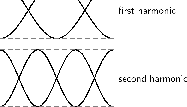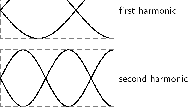| << Chapter < Page | Chapter >> Page > |
A wind instrument is an instrument that is usually made with a pipe or thin tube. Examples of wind instruments are recorders, clarinets, flutes, organs etc.
When one plays a wind instrument, the air that is pushed through the pipe vibrates and standing waves are formed. Just like with strings, the wavelengths of the standing waveswill depend on the length of the pipe and whether it is open or closed at each end. Let's consider each of the following situations:
If you blow across a small hole in a pipe or reed, it makes a sound. If both ends are open, standing waves will form according to [link] . You will notice that there is an anti-node at each end. In the next activity you will find how this affects the wavelengths.

This chart shows some standing waves in a pipe open at both ends. The pipe (shown with dashed lines) has length L.
| Wave | Nodes | Antinodes | Wavelength |
|
|
|
|
|
|
|
|||
|
|
|||
|
|
|
|
|
The formula is different because there are more anti-nodes than nodes. The right formula is:
Here, is still the number of nodes.
An open organ pipe is 0,853 m long. The speed of sound
in air is 345 m.s
. Can this pipe play middle C? (Middle C
has a frequency of about 262 Hz)

The main frequency of a note is the fundamental frequency. The fundamental frequency of the open pipe has one node.
We need to find the wavelength first.
This is lower than 262 Hz, so this pipe will not play middle C. We will need a shorter pipe for a higher pitch.
A flute can be modeled as a metal pipe open at both ends. (One end looks closed but the flute has an embouchure , or hole for the player to blow across. This hole is large enough for air to escape on that side as well.)If the fundamental note of a flute is middle C (262 Hz) , how long is the flute? The speed of sound in air is 345 m.s .
We can calculate the length of the flute from but:
Now let's look at a pipe that is open on one end and closed on the other. This pipe has a node at one end and an antinode at the other. An example of a musicalinstrument that has a node at one end and an antinode at the other is a clarinet. In the activity you will find out how the wavelengths are affected.

This chart shows some standing waves in a pipe open at one end. The pipe (shown as dashed lines) has length L.
| Wave | Nodes | Antinodes | Wavelength |
|
|
|
|
|
|
|
|||
|
|
|||
|
|
|
|
|
The right formula for this pipe is:
A long wavelength has a low frequency and low pitch. If you took your pipe from the last example and covered one end, you should hear a much lower note! Also, the wavelengths of the harmonics for this tube are not integer multiples of each other.
A clarinet can be modeled as a wooden pipe closed on one end and open on the other. The player blows into a small slit on one end. A reed then vibrates in the mouthpiece. This makes the standing wave in the air. What is the fundamental frequency of a clarinet 60 cm long? The speed of sound in air is 345 m.s .
We are given:
This is closest to the D below middle C. This note is one of the lowest notes on a clarinet.
The 12 tone scale popular in Western music took centuries to develop. This scale is also called the 12-note Equal Tempered scale. It has an octave divided into 12 steps. (An octave is the main interval of most scales. If you double a frequency, you have raised the note one octave.) All steps have equal ratios of frequencies. But this scale is not perfect. If the octaves are in tune, all the other intervals are slightly mistuned. No interval is badly out of tune. But none is perfect.
For example, suppose the base note of a scale is a frequency of 110 Hz ( a low A). The first harmonic is 220 Hz. This note isalso an A, but is one octave higher. The second harmonic is at 330 Hz (close to an E). The third is 440 Hz (also an A). Butnot all the notes have such simple ratios. Middle C has a frequency of about 262 Hz. This is not a simple multiple of 110 Hz. So the interval between C and A is a little out of tune.
Many other types of tuning exist. Just Tempered scales are tuned so that all intervals are simple ratios of frequencies.There are also equal tempered scales with more or less notes per octave. Some scales use as many as 31 or 53 notes.

Notification Switch
Would you like to follow the 'Siyavula textbooks: grade 11 physical science' conversation and receive update notifications?